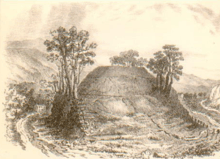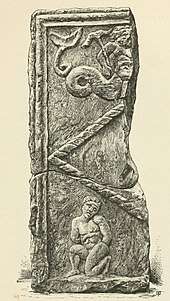Christian Maclagan
Christian Maclagan (1811–10 May 1901) was a Scottish antiquarian and early archaeologist.[1] She is known for her collection of rubbings of Celtic crosses and Pictish stones from across Scotland, and was a pioneer of stratigraphic excavation.[2] Although she lost the use of her right hand due to a medical condition she nevertheless produced numerous drawings, sketches and paintings with her left hand.[3] She took action to help those affected by poverty in Stirling.[4] She refused to sit for portraits although one obituary described her as tall. She was a suffragist. She wrote an autobiography but the script remains lost.[5] She was nominated to be one of Scotland's Heroines honoured at the National Wallace Monument's Hall of Heroes.[6] She died in Ravenscroft, Stirling.[7]
Christian Maclagan | |
|---|---|
| Born | 1811 Braehead, Denny |
| Died | 10 May 1901 Ravenscroft, Stirling |
Early life

Daughter of distiller and chemist George Maclagan and Janet Colville of Stirling, she was born on the family's farm at Braehead near Denny.[8] Her father died in 1818, as did her paternal grandfather, Frederick Maclagan, parish minister at Melrose,[9][10] and her mother moved the family to Stirling. She lived in a house in Pitt Terrace, a wealthy part of the town near St Ninian's Well and the modern Stirling Council offices.[11]
Her mother died in 1858, and until that time Christian Maclagan engaged in philanthropic activities, establishing a Sunday School and subscribing towards the cost of a library.[12] After the Disruption of 1843 she joined the Free Church of Scotland and in 1865 she funded the building of a new kirk.[13] Her relationship with the Free Church soured in the 1870s and she sued to reclaim the church which she then gifted to the established Church of Scotland. She apparently received a bequest from one of her brothers at around the time of her mother's death, and this established her as a woman of some wealth. Her estate was valued at 3100 pounds sterling at her death.
She was well-educated, knowing Latin, French, Greek, and Gaelic well — her paternal grandfather had tried his hand at a translation of the Bible into Gaelic. She also spoke some Italian and was an artist of some skill.
Antiquarian activities

Maclagan theorised that megalithic circles and tombs were the remnants of houses and forts. She believed an academic examination of all such sites would reveal a message, through the archaeological 'language' needed for such examination. The findings of her investigations included rubbings from hundreds of archaeological specimens of various sites and were published at her own expense. She carried out an excavation on the Mither Tap[18] of Bennachie.[19] Some of her theories were considered eccentric to her contemporaries. The dismissal of her views could be due to sexist attitudes of her era, or due to the anthropological comments Maclagan would make alongside her archaeological studies. At least one author criticized her work despite, presumably because of her Christian name, mistaking her for a man.[20]
One of her primary interests were in the brochs of Scotland and she also was one of the pioneers of stratigraphic excavation. She devised a special method for taking rubbings from sculptured stones; the exact details of how this was done were kept secret.[21] Possibly her greatest contribution to posterity was her meticulous collection of rubbings of Celtic Christian crosses and Pictish symbol stones, made from c 1850 onwards.[22] These rubbings include some of the earliest done at Wemyss Cave.[23]
As a woman Maclagan was disbarred from obtaining a fellowship of the Society of Antiquaries of Scotland, and instead she was merely a Lady Associate as were Lady John Scott and Queen Victoria. She told friends she was an antiquarian before Queen Victoria was born.[24] Later she threatened to resign the title since the society read her papers in her absence without her having the opportunity to respond.[12] She could not formally publish with the Society and required a man to publish her work under his name.[23] As a result of this, it has been supposed, she sent her rubbings to the British Museum.[25] She remained a Lady Associate however until the time of her death around the age of 92.[26] The Smith Museum in Stirling contains one of her models of a broch tower and a wooden carving as a tribute to her.[27] She was buried in Stirling's old town cemetery.
This sexism may also have led to her work being overlooked and one of her key discoveries Livilands Broch being lost. A crowdfunding project was launched in 2016 by Stirling Council's Archaeologist Dr Murray Cook to rediscover the broch that she discovered.[28][29]
Selected publications
- The Hill Forts Stone Circles and Others Structural Remains of Ancient Scotland, Edmonston and Douglas, 1875.[30]
- Chips from old stones 1881[31]
- What Mean These Stones?[32] D. Douglas, 1894 (described as a "slight and idiosyncratic work" by Euan MacKie).[4]
- A catalogue raisonné of the British Museum collection of rubbings from ancient sculptured stones. 1898[33]
- On the Round Castles and Ancient Dwellings of the Valley of the Forth, and its Tributary the Teith.[34][35]
- Notes of a Roman Sculptured Stone recently discovered at Cumbernauld, and of an Inscribed Stone at Stirling, &c. (With Photograph and Copy of the Inscription) (pp 178–9)[16][35]
Commemoration
A Historic Environment Scotland commemorative plaque was unveiled at 19 Clarendon Place, Stirling in August 2019.[36][37]
Bibliography
- The Biographical Dictionary of Scottish Women edited by Elizabeth L. Ewan, Sue Innes, Sian Reynolds, Rose Pipes (2008).
- Millar, A. H. (1912). . Dictionary of National Biography (2nd supplement). London: Smith, Elder & Co. pp. 531–532.

- Elsdon, Sheila M. (2004), Christian Maclagan: Stirling's formidable lady antiquary, Balgavies: Pinkfoot Press, ISBN 1-874012-43-1
- Scotsman, 13 May 1901;
- Sentinel (Stirling), 14 May 1901;
- Athenæum, 18 May 1901;
- Scots Magazine, 1818;
- Hew Scott's Fasti Eccles. Scot.;
- notes from Miss Maclagan's MS. autobiography, supplied by J. W. Barty, LL.D.;
- notes from W. B. Cook, Stirling;
References
- "Christian Maclagan Sensation of Scotland: Dibarred but Determined". TrowelBlazers. Retrieved 4 July 2018.
- Maclagan, Christian (1898). A Catalogue Raisonné of the British Museum Collection of Rubbings from Ancient Sculptured Stones ... Edinburgh: D. Douglas. Retrieved 4 July 2018.
- "Drawings by C MacLagan". Canmore. Historic Environment Scotland. Retrieved 4 July 2018.
- MacKie, Euan W. (2004). "Book Review: Sheila M. Elsdon Christian MacLagan: Stirling's formidable lady antiquarian". Scottish Archaeological Journal. 27 (1). Retrieved 4 July 2018.
- Davies, Mairi Helen. "An archaeological analysis of later prehistoric settlement and society in Perthshire and Stirlingshire" (PDF). Durham e-Theses. Durham University. Retrieved 4 July 2018.
- "Scotland's Heroines – Fourteen Remarkable Women". The National Wallace Monument. Retrieved 4 July 2018.
- Lee, Sidney (1912). Dictionary of National Biography. London: Smith, Elder & Co. pp. 531–532.
- Millar, Alexander Hastie; Lee, Sir Sidney (ed.) (1912). Dictionary of national biography. Second supplement (Vol II, 2nd supplement ed.). London: Smith, Elder and Co. pp. 531–532. Retrieved 4 July 2018.CS1 maint: extra text: authors list (link)
- Scott, Hew (1917). Fasti ecclesiae scoticanae; the succession of ministers in the Church of Scotland from the reformation. 2. Edinburgh: Oliver and Boyd. pp. 188–189. Retrieved 4 September 2019.
- Fordyce, A. D. (1888). Family record of the name of Dingwall Fordyce in Aberdeenshire [microform] : including relatives of both names separately and connections. 2. Ont.: Fergus. p. xxxi. Retrieved 4 September 2019.
- "OS 25 inch map 1892-1949, with Bing opacity slider". National Library of Scotland. Ordnance Survey. Retrieved 12 October 2017.
- Stopes, Charlotte C. (Obituary of Miss Christian Maclagan) (1901). The Englishwoman's review of social and industrial questions. New York: Garland Publishing. pp. 215–219. Retrieved 4 July 2018.
- "Tribute Britain's first woman archaeologist". The Stirling Smith. Retrieved 4 July 2018.
- "Distance Slabs". The Antonine Wall. CastlesFortsBattles.co.uk network. Retrieved 27 October 2017.
- Mitchell, Arthur (1881). The past in the present. What is civilization?. New York: Harper & brothers. p. 261. Retrieved 27 October 2017.
- MacLagan, Miss C. "Notes of a Roman Sculptured Stone recently discovered at Cumbernauld, and of an Inscribed Stone at Stirling, &c. (With Photograph and Copy of the Inscription) (pp 178-9)" (PDF). Retrieved 4 July 2018.
- "Fragment of possible Distance Slab, Arniebog, Westerwood". Retrieved 19 May 2018.
- "Mither Tap Of Bennachie". Canmore. Historic Environment Scotland. Retrieved 6 July 2018.
- "2.1 Antiquarian work and early syntheses". Scottish Archaeological Research Framework. Retrieved 6 July 2018.
- Lewis, A. L. (1888). "Stone Circles near Aberdeen". The Journal of the Anthropological Institute of Great Britain and Ireland. 17: 46. Retrieved 4 July 2018.
- The Scottish antiquary, or, Northern notes & queries (Vol XVI ed.). Edinburgh: W. Green & sons. 1902. Retrieved 4 July 2018.
- "Society of Antiquaries of London's Online Newsletter". Archived from the original on 13 June 2011.
- Hambly, Joanna. "Archaic sculpturings to 4D Wemyss". YouTube. Recording Archaeology. Retrieved 18 February 2015.
- Obituary (18 May 1901). "Miss Christian Maclagan". The Athenaeum. 3838 (January to June): 6344–635. Retrieved 4 July 2018.
- Cook, W. B. (1904). The Stirling Antiquary: Reprinted from "The Stirling Sentinel," 1888-[1906]. Stirling: Cook & Wylie. pp. 219–221. Retrieved 4 July 2018.
- Davies, Dr Mairi (FSA Scot). "The Invisible Women" (PDF). Society of Antiquaries. Retrieved 4 July 2018.
- ROSS, SHÂN (13 August 2016). "New archaeology dig honours victim of historic 'sexism'". The Scotsman. Retrieved 6 July 2018.
- McKenzie, Steven (12 August 2016). "Search for Stirling's lost Iron Age roundhouse". BBC. Tayside and Central Scotland. Retrieved 4 July 2018.
- "Christian Maclagan and Stirling's Lost Broch". christianmaclagan. Retrieved 4 July 2018.
- Maclagan, Christian (1875). The hill forts, stone circles, and other structural remains of ancient Scotland. Illustrated with plans and sketches. By Christian Maclagan, lady associate of the Society of antiquaries of Scotland. Edinburgh: Edmonston and Douglas. Retrieved 4 July 2018.
- Maclagan, Christian (1881). Chips from old stones. Edinburgh: George Waterston & Sons. Retrieved 4 July 2018.
- MacLagan, Miss Christian (1894). What mean these stones?. Edinburgh: D. Douglas. Retrieved 4 July 2018.
- Maclagan, Christian (1898). A catalogue raisonné of the British Museum collection of rubbings from ancient sculptured stones. A chapter of Scotland's history as it is written on its rocks and stones as 'with a pen of iron on the rock for ever,' also of who it was that did this writing, and of who it was that undid it, by Christian Maclagan. Edinburgh: D. Douglas. Retrieved 4 July 2018.
- MacLagan, Miss C. "On the Round Castles and Ancient Dwellings of the Valley of the Forth, and its Tributary the Teith. (pp 29-44)" (PDF). Retrieved 4 July 2018.
- "Proceedings". Society of Antiquaries of Scotland, 2003 (updated 2017). 9. 1870–72. Retrieved 4 July 2018.CS1 maint: date format (link)
- Cameron, Lucinda (26 December 2018). "Christian Maclagan: First female archaeologist to be honoured with a plaque". The Times. ISSN 0140-0460. Retrieved 1 September 2019.
- "Scotland's first female archaeologist honoured for pioneering work". www.scotsman.com. Retrieved 1 September 2019.